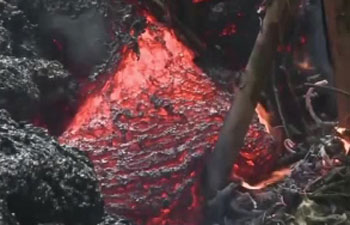by Peter Mertz
DENVER, the United States, May 16 (Xinhua) -- River waters are expected to rise again this week as officials in Montana caution that rain will worsen conditions after the Clark Fork River last week hit flooding levels not seen since 1908.
"Rapid snowpack melt and continued warm temperatures will be joined by thunderstorms at the end of this week, and that could make things worse," said Dave Noble from The National Weather Service (NWS) in Missoula.
Wednesday is expected to usher in another round of slow-moving rain showers followed by cooler weather on Thursday, the NWS said.
Missoula sits in the mountainous northwest corner of the state bordering Canada to the north. Noble told Xinhua on Tuesday that heavy winter snows are swelling streams and rivers with icy waters and hazardous debris.
Even 113 miles (190 km) away at the state capital Helena, "water was rising out of the ground," Maggie Truscott from the Helena Campground and RV Park told Xinhua, and that they had canceled reservations till the end of May due to the high water.
"We had an 8-foot-wide (some 2.4 m), 4-foot-deep (some 1.2 m) river flowing though our mobile home park. It caused widespread destruction," said Truscott, as the first wave of record floods hit last week.
By Tuesday, across the northwestern part of the state, waters had receded from record levels, but NWS officials warned residents to "avoid walking or driving through flood waters. Just 6 inches (0.15 m) of moving water can knock you down and 2 feet (0.61 m) of water can sweep your vehicle away."
Floodwaters knocked down power lines near Missoula over the weekend. Northwestern Energy shut off power to the lines, but they remain a danger to anyone using the river, officials said.
By Wednesday, emergency fire and rescue crews had saved a number of stranded residents with no fatalities thus far from the record runoff.
Environmental Protection Agency (EPA) officials worried about an environmental disaster.
They were busy warning Missoula Valley residents of water contamination, and assessing a 7-km-long berm that contained the state's largest volume river, the Clark Fork, just 11 miles (18.6 km) northwest of Missoula.
That berm is stopping the river from flooding the former 3,200-acre (12.9 -square km) Smurfit-Stone site, a pulp mill that ran from 1957 to 2010, and was unregulated for many years, leaving 160 acres (0.64 square km) of contaminated soil in its wake.
The Clark Fork River watershed has a drainage area upstream of the old mill site of approximately 9,000 square miles (23309 square km), according to a 1988 study by the Federal Emergency Management Agency.
Dangerous, cancer-causing dioxins, mercury and other hazardous materials are still contained in soils there, say the EPA and the Montana Department of Environmental Quality.
The earthen berm holding back the Clark Fork from possible catastrophic contamination of this enormous waste site was inspected by U.S. Army Corps of Engineers officials again last week and found to be safe, officials reported.
EPA's Sara Sparks told Xinhua that her group has done extensive analysis, and found the 10-feet-high (3.05-m-high) berm to be solid and capable of withstanding the might Clark Fork's rise "by several feet."
"Investigation of the Smurfit-Stone Mill site is ongoing to determine the nature and extent of contamination," EPA's Montana website said.
"We are watching very closely and not worried the water will enter the site," Sparks told Xinhua.
The Clark Fork River is expected to go back up to major flood stage, which is at 13-feet (3.96 m), sometime Thursday afternoon, and is expected to crest at 13.98 feet (4.2 m) sometime Friday night or Saturday morning, the EPA said Tuesday.
Meanwhile, local environmental groups expressed concern that more rain might tip the balance and unleash the Clark Fork into the toxic waste site.
"We want to see stronger enforcement from the agencies in charge of getting this cleaned up." Clark Fork Coalition Director Karen Knudsen told the Missoula on Monday.
Knudsen said a similar scenario played out with the removal of Milltown Dam upstream of Missoula.
Arsenic and copper from historic mining had contaminated the Milltown Reservoir where by 2009 the EPA had drained the reservoir and removed three million tons of contaminated sediment at a site called the largest and most expensive Superfund site in the United States, according to a 2015 EPA study.
The EPA had estimated it would take between 200 and 2000 years to naturally deplete this source of arsenic in Milltown Reservoir sediments, but that after the arsenic was removed the water will be safe to drink within a decade.
The contamination resulted from a massive flood in 1908 that washed 6.6 million cubic yards (84,000 cm) of sediment contaminated with arsenic, lead, zinc, copper, and other metals into the Clark Fork River and ending up in the Milltown Reservoir, according to the EPA.
And while EPA officials are slammed up with Montana's 17 major Superfund cleanup sites, mostly from deadly mining runoff waste, state environmentalists fear more damage may be caused soon.
"Every year, we keep our fingers crossed hoping we're not going to be dealing with a situation like this," Knudsen said.













